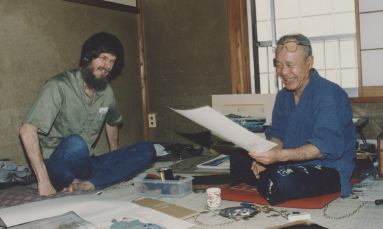One-point Lesson : Storing Pigments
Lesson #6: Pigment preserved in alcohol ...
Working both as carver, printer and publisher as I do, weeks sometimes go by without my touching the printing tools. I average about twelve prints per year, and am thus only a 'printer' for three or four days each month. Printing on a 'part time' basis like this creates many problems, not the least of which is the fact that my callouses disappear during the weeks of carving, and the first day of printing each time can thus be quite painful!
Mixing colour is another area of difficulty. I use the Japanese dry pigments known as ganryo, and each time I want to create a colour, I must first select, grind and then dissolve each of the basic ingredients that I think will be needed for it. As the mixing process proceeds, I frequently find that I want just a touch of another ingredient in my colour, and must thus go through the grinding, etc. with the new pigment that I want to add. It's troublesome and wasteful.
Keizaburo Matsuzaki-san has a better way. On a shelf in his workshop stands a row of jars containing his collection of basic pigments, not in powder form, but ground and soaked in alcohol. There is just enough alcohol in the mix to keep each pigment in a moist and pasty form. As he mixes a colour for his current print, he simply takes a spoonful of one, a dab from another, and a 'touch' from still another ... It is a moment's work to blend them together in his pigment bowl, and no further grinding or other preparation is needed.
I should emphasize that he does not have a very large selection of these pre-mixed colours. In a typical Japanese pigment shop the walls are covered right to the ceiling with rack after rack of delicately blended shades - the greens here, the blues there ... Those pigments are for the use of painters working in the 'nihonga' style. Woodblock printmakers do not 'purchase' colours, they 'create' them.
Here is his 'palette':
- ai - indigo
- prussian blue
- shu - vermillion
- hon yo ko - a deep and dark red
- bengara - a rusty brown red
- seki-wo - a yellow compound
- sumi - carbon black
With this quite small selection, he can create any tint that you care to imagine. I've watched him do it ... studying the sample in front of him for a moment, and then reaching for the jars he needs. Scoop out the pigments in the quantities he thinks will be necessary (no measuring or weighing ...), blend them in water, swab it on the block to take a sample proof ... 'bingo' ...
Alcohol ... nothing like it to make the work go smooth and easy!

An Encyclopedia entry on preparing these pigments is here.
